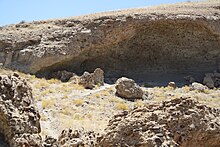Henno Martin

Henno Martin (born March 15, 1910 in Freiburg im Breisgau ; † January 7, 1998 in Göttingen ) was a German geologist .
Life
Henno Martin left Germany in 1935 as a freshly graduated geologist with his friend and colleague Hermann Korn and traveled to the area of the former German colony of German South West Africa , at that time the mandate area South West Africa under the administration of the South African Union (today Namibia ) without a research assignment from the state or official side . In Walvis Bay landed, they began mapping the Naukluftgebirges and explored water resources for farmers.
After the beginning of the Second World War , like other Germans in South West Africa , he had to fear that he would be arrested and interned as an enemy foreigner. For this reason, he and Hermann Korn fled to the desert around the Kuiseb canyon west of Windhoek in 1940 , where the two of them led a primitive hunter's life for two and a half years and hid from the police and locals. Martin's struggle for survival in the desert is described in his book When there is war, we go to the desert .
After the two and a half year adventure, which the two had to end because of a vitamin deficiency Korns, he was arrested on his return to civilization, but was quickly released because of his apolitical attitude and was stopped by the South West African Mandate Government in the hydraulic engineering office, where he started his search continued after water availability.
Henno Martin worked at the Geological Survey of the Republic of South Africa and was a professor at the University of Cape Town . From 1958 to 1960 he was visiting professor in São Paulo ( Brazil ). In 1965 he accepted a position as professor of geology at the University of Göttingen . In 1967 he was elected a corresponding member of the Göttingen Academy of Sciences .
The Geological Association awarded Henno Martin the Gustav Steinmann Medal in 1980 in recognition of his fundamental work on the development and breakup of the Gondwana continent, which significantly expanded knowledge of the mechanisms of old and young global tectonics .
Fonts
- If there is war we go to the desert . Union Deutsche Verlags Gesellschaft, Stuttgart 1956 (original edition), ISBN 978-3935453028 .
- The Hypothesis of Continental Drift in the Light of Recent Advances of Geological Knowledge in Brazil and in South West Africa . Geological Society of South Africa, 1961.
- The Precambrian Geology of South West Africa and Namaqualand . University of Cape Town, Precambrian Research Unit, Cape Town 1965
Cinematic reception
- Regardt van den Bergh : The Sheltering Desert , South Africa 1991, with Jason Connery , Rupert Graves and Joss Ackland (film adaptation of the book When there is war, we go into the desert )
Web links
- Literature by and about Henno Martin in the catalog of the German National Library
- Chronology of the stay of Henno Martin and Hermann Korn in Namibia
- Obituary (English) Geological Society of America, December 29, 1998
Individual evidence
- ^ List of members . In: Yearbook of the Göttingen Academy of Sciences . tape 1999 , 2000, pp. 17 .
| personal data | |
|---|---|
| SURNAME | Martin, Henno |
| BRIEF DESCRIPTION | German geologist |
| DATE OF BIRTH | March 15, 1910 |
| PLACE OF BIRTH | Freiburg in Breisgau |
| DATE OF DEATH | January 7, 1998 |
| Place of death | Goettingen |